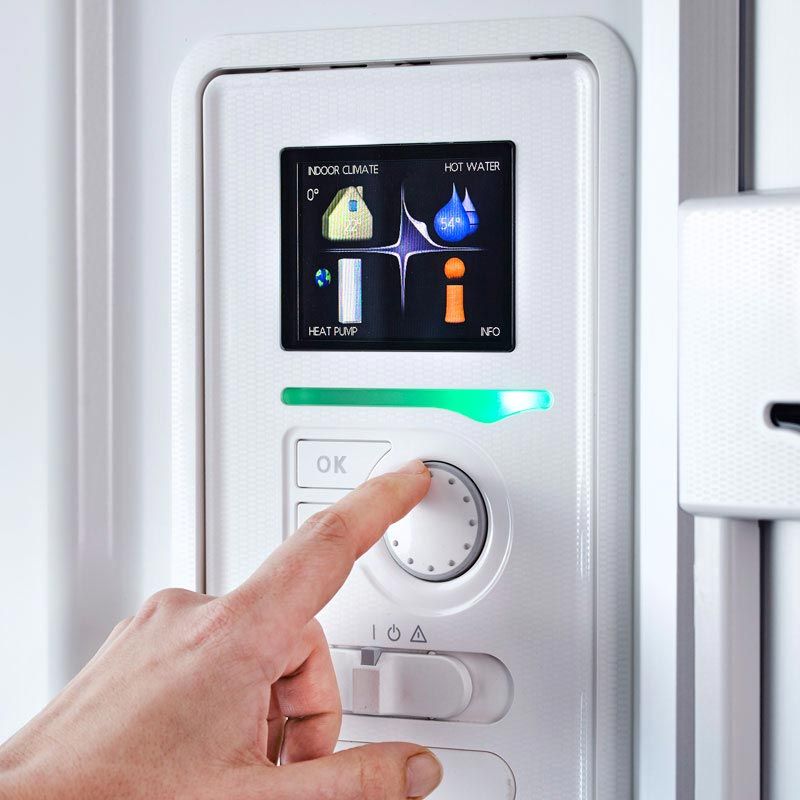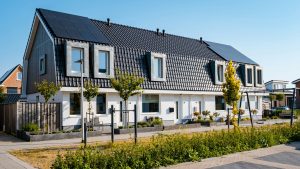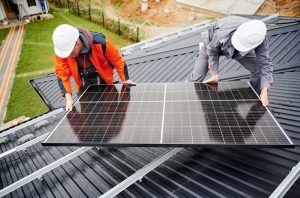Air to water heatpumps
Air to Water Heatpumps might be new to Irish people but it is far from new technology. In fact, the technology is over 40 years old and has been heating Scandinavian homes for decades.
What is an Air to Water Heatpump?
Simply put an Air to Water Heatpump is like your fridge in your kitchen but in reverse, it produces heat instead of making cold. It is run by electricity and comprises of a unit that looks very like an air conditioning unit that sits in your back garden.
Connected to this unit are 2mm x 32mm insulated pipes running from the outdoor unit to the indoor cylinder unit (Monobloc system). These pipes bring hot water to your heating system and your hot water system.
Now for the technical part, how does the Air to Water Heatpump make this heat? Believe it or not there is enough heat in the air down to -25 degree’s for the heatpump to supply heat into your heating system. This is simply how the Heatpump does this:


How the Heatpump Works
- The Air to Water Heatpumps source of heat is the outside air which is blown over the heat exchange surface of the outside unit of the heat pump.
- There is enough heat in this outside air right down to -25 degree’s to boil the special refrigerant liquid. This causes the refrigerant to turn from a liquid into a gas (evaporating)
- This gas is then pushed through a compressor which increases the pressure of the gas which in turn makes the gas hotter. The best example of this is when you pump your bike tyre up and the pump gets really hot.
- Our heated gas is then passed over a heat exchanger surface. The house heating system water is connected to the other side of the heat exchanger and gets heated before being transferred through our two pipes into the house to heat the underfloor heating and the hot water cylinder.
- The gas temperature starts to drop as the house is taking its heat. As the gas temperature drops it starts to turn back into a liquid
- The liquid refrigerant returns to the outside heat exchange surface and the process repeats itself Until the house stops looking for hot water or heating.
New Builds
Green-house have recognised that in order for a new build house to meet the strict Part L building regulations a new build house has to have some Renewable energy helping the house’s energy requirements. Builder’s basically have 2 options:
- Gas Boiler + PV or Thermal Solar
- Air to Water Heatpump system
We feel the best option for a new build is an Air to Water heatpump system. it provides maximum levels of comfort and the cheapest running costs, in fact it’s a “no brainer”. Its also an extremely simple system for the end user to live with.
A new build house needs to be a minimum of an A3, this means the house has very low heat loss. We set up all our heatpumps to run 24/7 meaning you always have a warm house and always hot water.
The heatpump complex controller will look after everything. All that required from the homeowner is set their thermostats to their desired room temperature ( design temperatures are 21 degree’s for living areas, 19 degree’s for bedrooms). The air to water heatpump can provide this level of comfort very cheaply, approx. €400 for 150 sqm new build house.


Retro Fitting
Heatpumps are suitable for the majority of renovation / retrofits in the modern era of building, but every house is different. A heatpump is very different from a standard gas boiler system,a heatpump supplies water to the heating system at 30 – 45 degree’s but for longer periods, where a gas boiler supplies hot water at 60 – 70 degree’s in short bursts. The best gas boiler on the market is 97% efficient, where our where our Nibe F2040 is 413% efficient. This allows us to give the Heatpump a license to run 24/7. In a new build this is suitable, but obviously a retrofit is different as the heat loss will more than likely be far higher.
Here at Green-house we do a full design and survey of the house and heating systems (radiators or underfloor) to see if the heatpump will be a suitable system to provide the maximum levels of comfort and cheap running costs.Usually houses with Underfloor heating are suitable. With radiator systems we need to make sure that the radiators are sized to work with the heatpump. after we have established this we need to look at getting a comprehensive BER done on the property to fully ascertain if the Heatpump will work effectively.
A full review of the heating controls is also needed to tailor the system to the house its heating. Building and insulation standards have been raised in Ireland in the past few years and we are finding that most retrofit projects are Heatpump compatible, in fact the savings versus gas / oil are far higher in these projects, usually 60% cheaper than oil & 40% cheaper than gas!
Blog
Useful resources

Finding the Best Solar Panels in Ireland: A Short Guide
The quest for sustainable energy solutions in Ireland has led many homeowners and businesses to consider solar energy as a viable option. With the increasing

How Much Are Solar Panels in Ireland? A Comprehensive Cost Breakdown
As Ireland continues to embrace renewable energy sources, solar panels have become a popular choice for homeowners looking to reduce their carbon footprint and save

How Do Solar Panels Work? A Simple Guide to Understanding Solar Energy
Have you ever wondered how solar panels convert sunlight into electricity? With the growing interest in renewable energy sources worldwide, solar panels are becoming a
